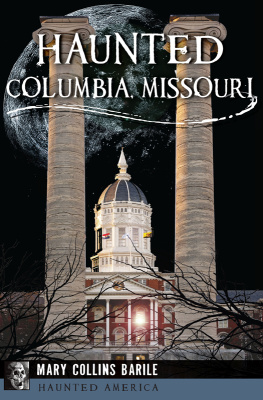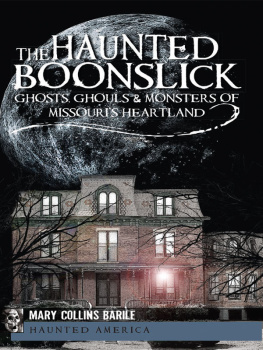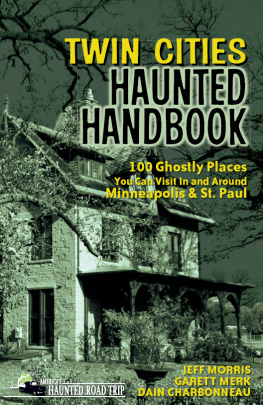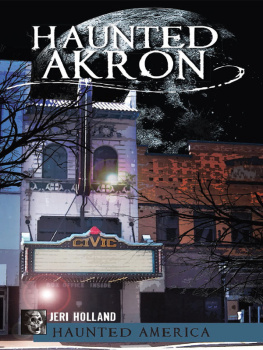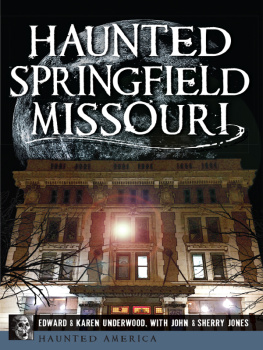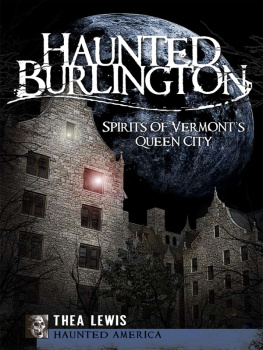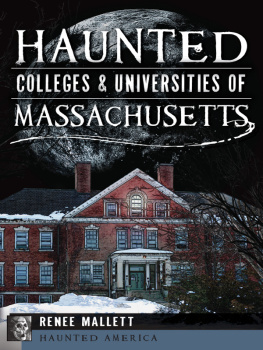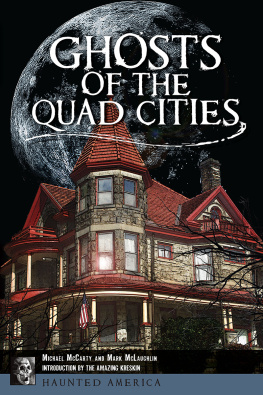ACKNOWLEDGEMENTS
There are many people who contributed personal stories and photographs to this collection, and for their generosity and time, I am grateful. Some asked that I not mention their names or specific locations of certain events, but know that each of these stories has been shared in detail, and I have little doubt the experiences were as real to the teller as I hope they will be to readers. In addition, thank you to those friends who followed me through cemeteries, over dark hills and into haunted houses and offered advice and information. They include Sarah Arrandale, Mary Arrandale, Linda Cooperstock, Tina Edholm, James Henderson, Arlene Hoose and Jane Lago. Ben Gibson and Rick Delaney are the best editors a writer could ask for, and Arcadia/The History Press is always a delight to work with. Tina Edholms photographs capture the mystery of hauntings with beauty and style. Finally, to the staff of the Missouri Humanities Council, your support has been most appreciated.
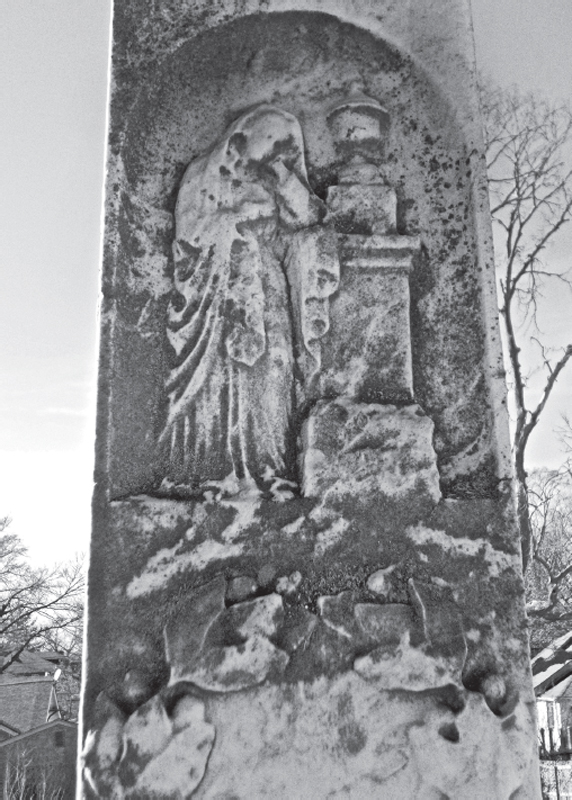
Grave markers often included depictions of mourning women leaning against the memorial of the departed.
ABOUT THE AUTHOR

Mary Collins Barile is pleased to note that while Mark Twain was born in Missouri and died in New York, she left her natal New York City and currently lives in Boonville, Missouri. Perhaps not an equal trade but at least an even one. She is a teacher and writer and has a PhD in theater from the University of Missouri. Her house is not haunted, and she hopes to keep it that way.
SUGGESTED READINGS
Bouton, J.B. Two Years Among the Spirits. Liberal, MO: Bouton, 1888.
Christensen, Lawrence O., ed. Dictionary of Missouri Biography. Columbia: University of Missouri Press, 1999.
Darrough, J., et al. A Boone County Album. Columbia, MO: Boone County Historical Society, 1971.
Guitar, Odon. Address of General Odon Guitar. University Magazine 3 (January 1890): 253.
History of Boone County, Missouri. St. Louis, MO: Western Historical Company, 1882.
Randolph, Vance. Ozark Superstitions. New York: Columbia University Press, 1947.
Richards, John Thomas. SORRAT: A History of the Neihardt Psychokinesis Experiments, 19611981. Metuchen, NJ: Scarecrow Press, 1982.
Rothwell, Dan A. Along the Boones Lick Trail. Chesterfield, MO: Young at Heart Publishing, 1999.
Sampson, F.A. Glimpses of Old Missouri by Explorers and Travelers. Missouri Historical Review 1, no. 4 (1907).
Sheals, D., for the Downtown Columbia Association. National Register of Historic Places, Multiple Property Documentation Form, Nomination for Columbia Business District, 2003.
Skinner, Charles M. American Myths and Legends. Philadelphia: J. Lippincott, 1903.
. Myths and Legends of Our Own Land. Philadelphia: J. Lippincott, 1896.
Smith, William Benjamin. James Sidney Rollins. New York: De Vinne Press, 1891.
Sutherland and McEvoy. Missouri State Gazetteer and Business Directory. St. Louis, MO: Sutherland & McEvoy, 1860.
Switzler, William Franklin. Switzlers Illustrated History of Missouri, 1541 to 1881. St. Louis, MO: C.R. Barns, 1881.
Van Ravenswaay, Charles, ed. Missouri: A Guide to the Show-Me State. New York: Duell, Sloan and Pierce, 1941.
Wetmore, Alphonso. Gazetteer of the State of Missouri. St. Louis, MO: C. Keemle, 1837.

COLUMBIAS HISTORY
Members of the Mississippian culture settled in the Columbia region as early as AD 1400, but little is known of their life in the region, and less is known of their lore and traditions. It is possible that French and Spanish explorers and trappers made their way into mid-Missouri as early as the seventeenth century, but it wasnt until the Louisiana Purchase that a U.S. government survey was undertaken. In 1803, Lewis and Clark traversed this region on their way west, impressed by the prairies, bluffs and wildlife along the Missouri River. Migration to the Boonslick region, named after a natural salt lick worked by sons of the Boone family, increased during the War of 1812, when settlers moved into the area encompassed by modern Boone County. Although settlers arrived from New York, Vermont and Connecticut, migration from Virginia, Kentucky and Tennessee was so great that the area around present-day Columbia was eventually nicknamed Little Dixie. The region developed into a center of agriculture, with hemp, tobacco, wheat and corn shipped downriver to St. Louis. Columbia had its bureaucratic beginnings in 1818, when the Smithton Land Company purchased acreage and established Smithton, named in honor of General T.A. Smith, the receiver in the Franklin Land Office and an original investor in the town site. By 1819, the Smithton investors were advertising in the Missouri Intelligencer for someone to build a double hewed log house, shingled roof and stone chimneys, one story and a half high.... They will also contract for digging and a well, an activity that proved prescient in the light of later problems. Boone County was eventually trimmed from Howard County and established in 1820; by 1821, Missouri was a state. But in a reversal of fortune, Smithton realized that its wells were not enough for a growing town. The lack of a dependable water source forced the Smithtonians to pack up the entire settlement and move it a mile away, near Hinkson Creek and the Flat Branch. The new village was named Columbia, in honor of the young country, and the city began its history.
The original plat for Columbia included more than four hundred lots, with land set aside for private and public use. Broadway was part of the Boonslick Trail, which ran from St. Louis to Franklin, where it connected with the eastern terminus of the Santa Fe Trail. By 1824, there were 160 people living in Columbia, and the population tripled again in a decade. The city was bustling, with businesses and homes lining streets that were uncommonly wide for the time. That was due to the vision of William Jewell, who insisted on streets that were big enough to host livestock sales without impeding human travelers. (He also supported regulations to reduce the dumping of offal from slaughterhouses and increase the number of gutters, drains and sidewalks.) By 1837, the Gazetteer of Missouri noted that Columbia had twelve stores, three churches, a mail route and a universitya far cry from the first ramshackle cabins and dry well.
Part of Columbias success was due to the establishment of private and public schools. In 1833, Lucy Wales established the Columbia Female Academy, which later evolved into Stephens College. A few years later, the town leaders decided to compete for the first state university established within the old Louisiana Territory. More than 900 townspeople pledged $118,000 in support of the idea, beating out Boonville and other towns in the process. In 1839, the University of Missouri opened in Columbia. The Christian Female College was founded next, in 1851, and was later known as Columbia College. By 1860, the Missouri State Gazetteer and Business Directory noted that Columbia was a thriving center of education and commerce with a population of more than 1,400 townsfolk. Among them were dressmakers, surgeons, wagon makers, tinsmiths, factory owners, cabinetmakers, newspaper editors, livery stables owners and milliners.
Next page
